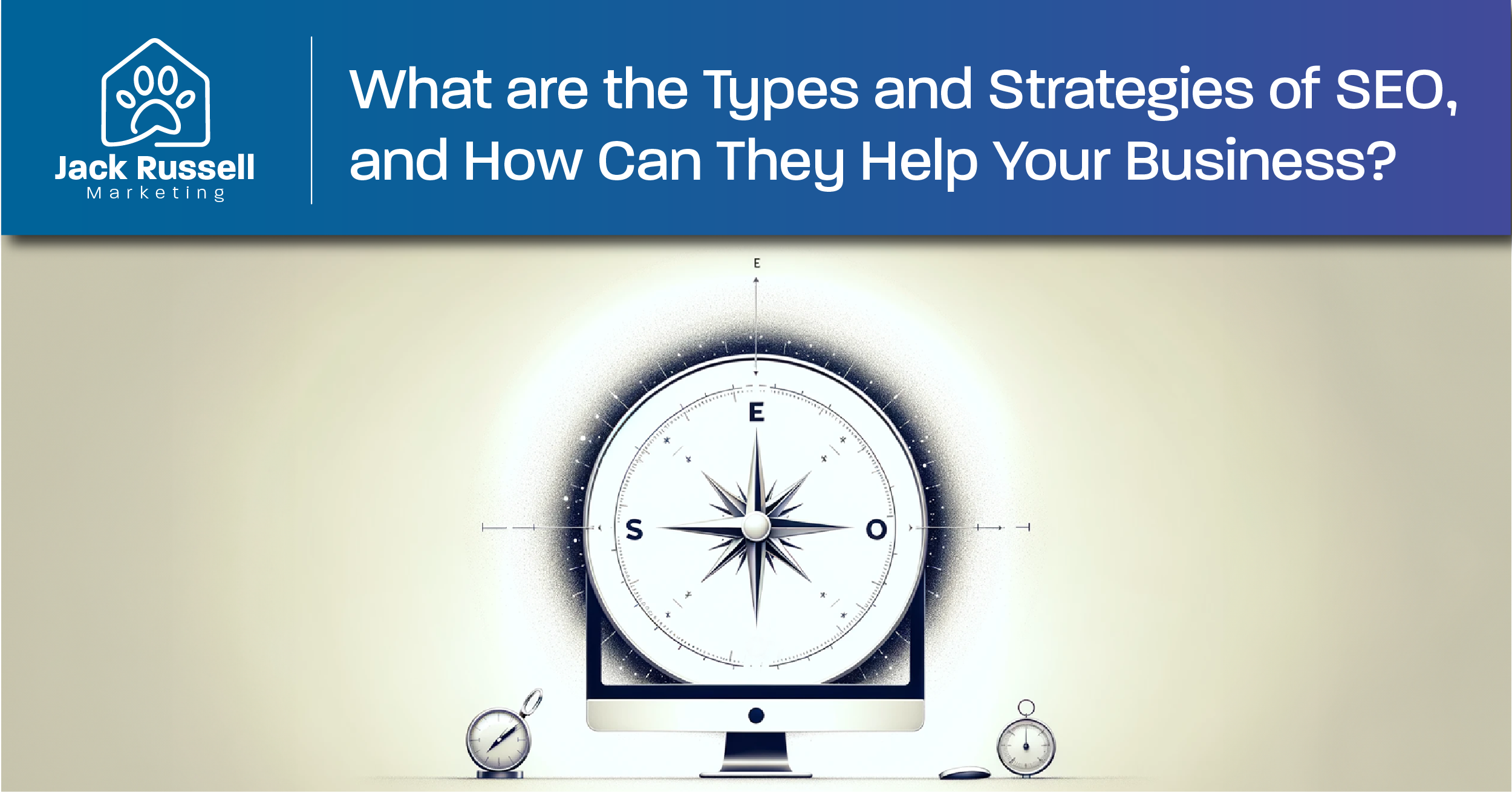What are the Types and Strategies of SEO, and How Can They Help Your Business?

In today’s digital-first world, SEO is not just an addition to your marketing strategy—it’s a cornerstone. Elevating your website to the top of search engine results can dramatically transform your business, turning online visibility into tangible benefits. SEO, with its dynamic and multifaceted nature, acts as the lifeblood of digital marketing, unlocking a realm of opportunities for businesses keen on growth and visibility.
This guide delves into the core types of SEO and unveils strategic approaches to harness its full potential. Plus, we’ll share actionable insights to elevate your online presence and captivate more potential customers. By mastering the diverse aspects of SEO, you can tailor your strategies to fit your business’s unique needs, maximizing every effort you put forth.
Three Main Types of SEO
1. On-Page Optimization for Better Search Engine Rankings
On-page optimization is the process of optimizing web pages for better search engine rankings. It involves optimizing various components of a website such as meta tags, titles, headings, and content to make it more visible and attractive to search engines.
On-Page Optimization includes optimizing the content, structure, and HTML code of a website to make it more search engine friendly. It also involves optimizing the website for keywords and phrases that are relevant to the target audience.
By improving On-Page Optimization, webmasters can ensure that their websites are well-structured, optimized for keywords, and contain quality content that is relevant to their target audience. This will help them rank higher in search engines and bring more organic traffic to their websites.
2. Keyword Research – The Foundation of a Successful SEO Strategy
Keyword research is the foundation of a successful SEO strategy. It is a process that involves researching and analyzing keywords related to your business, products, services, and industry in order to create content that will rank well in search engine results.
The keyword research process involves finding the most relevant and popular keywords related to your business, as well as identifying long-tail keywords that can be used to target specific audiences. It also involves analyzing the competition for these keywords in order to determine which ones are most likely to bring you the best organic search traffic. By taking an in-depth look at keyword research, you can create an effective SEO strategy that will help you achieve your goals.
3. Content Marketing & Link Building – The Power Couple to Increase Traffic & Sales
Content marketing and link building are two essential components of any successful SEO strategy. Content marketing is the process of creating and distributing valuable, relevant, and engaging content to attract and retain a clearly defined audience with the goal of driving profitable customer action. Link building, on the other hand, is the practice of acquiring hyperlinks from other websites to your own in order to increase search engine rankings. Together, these two strategies can be used to drive traffic and sales for any website or online business.
12 Types of SEO Strategies and How to Use Them for Maximum Results
Now that we have covered the basics of different SEO types, let’s examine 12 different SEO approaches and how to use them to maximize your efforts. We’ll explore the details of each strategy.
1. White-Hat SEO
White-hat SEO is an optimization technique that follows the rules and regulations of major search engines, chiefly Google. It’s a method to ensure that content ranks well on SERP while abiding by the guidelines of search engine algorithms.
2. Black-Hat SEO
Black-hat SEO involves manipulating Google’s algorithm to gain a higher ranking in its SERP. This is done by taking advantage of any vulnerabilities or loopholes in the system. Completing certain activities like spam link building, keyword stuffing, and cloaking for SEO benefits can give you quick results but can also be detected by Google and cause a lot of harm to your website. That’s why it is best to stay away from black hat SEO practices.
3. Gray-Hat SEO
Gray-hat SEO is a practice that straddles between white-hat and black-hat tactics. It carries more risk than white-hat SEO as the regulations and guidelines are not clearly defined. However, using gray-hat SEO practices will not result in site ban from search engines.
4. On-Page SEO
On-Page SEO is a great tool to improve the ranking of your website in search engines as well as make it more user-friendly. It involves optimizing components of a web page, such as title tags, internal links, HTML code, URLs, and images to meet the expectations of search engines.
5. Off-Page SEO
Off-page SEO involves optimizing the visibility of your website outside of your own domain. It encompasses activities like paid social media advertising, obtaining positive customer reviews on various forums, and garnering high-quality backlinks from authoritative sources in the same niche as yours.
6. Technical SEO
The main purpose of technical SEO is to make sure that Google’s spiders are able to successfully crawl, understand and index the webpages of your website.T o improve your website’s search engine visibility and rankings, two effective techniques are creating an XML sitemap and making it mobile-friendly. This allows web crawlers to easily filter and categorize the pages according to its content.
7. International SEO
For global success, it is important to optimize your website for international SEO. Doing so will help increase organic traffic from various countries and languages. You should also be aware of the cultural context of your target audience, as well as facilitate transactions in their local currencies and languages for a better user experience.
8. Local SEO
Local SEO strategies for local businesses are one of the most important types of SEO, as they help businesses become more visible in local search results on Google. Local SEO helps businesses reach local audiences by analyzing their behavior through trillions of searches.
9. Ecommerce SEO
By utilizing Ecommerce SEO, businesses are able to get better visibility in search engine results without having to pay for expensive ads. This can result in more organic traffic and higher rankings when customers search for products or services related to your business.
10. Content SEO
Content SEO is a type of SEO that’s becoming more common. It involves creating interesting, unique content in the form of writing, graphics or videos for your website to improve its rankings in SERP results. Content SEOs require careful consideration with regards to copywriting, site structure and keyword strategy for effective outcomes. All three components must be carefully evaluated for optimal performance.
11. Mobile SEO
Mobile SEO refers to the optimization of webpages so that they can be indexed and viewed correctly on smaller devices such as smartphones and tablets. his includes ensuring that the webpages have an attractive and user-friendly layout, clear structure, and fast loading speed so that mobile users don’t experience any inconvenience while browsing.
12. Negative SEO
Negative SEO is an unethical tactic used to harm competitors’ search engine rankings for unlawful gain. It involves techniques such as building low-quality backlinks, creating duplicate or thin content and targeting competitor websites with malicious code. All of these activities are meant to lower the ranking of a competitor’s website, so that one’s own site can rise in comparison.
Ready to jumpstart your SEO optimization? Let's get goin'!
If you want to make sure your business stands out from the competition, you need to understand the types and strategies of SEO. From keyword research to link building, there are a variety of ways you can boost your website’s visibility and drive more traffic. With the right SEO tactics, you can maximize your search engine rankings and improve your online presence. In this article, we’ve discussed the various types and strategies of SEO so that you can make an informed decision on how to best optimize your website for success.
Recent Publications

Why Purpose-Driven Marketing Creates Loyal, Lifelong Customers
Purpose-driven marketing doesn’t just sell products—it builds relationships. Learn how connecting with your audience’s values transforms customers into lifelong advocates for your brand.

Don’t Tell Them About Your Product—Show Them
Visual storytelling transforms products into experiences. Learn the psychology, strategy, and techniques behind creating visuals that captivate audiences and convert them into loyal customers.

The Art of Collaborative Storytelling: How Strategic Partnerships Drive Sales and Build Trust
Collaborative storytelling transforms partnerships into powerful sales tools. Learn how to craft campaigns that inspire trust, engage audiences, and deliver measurable results.
